|

Introduction
The growth in gaming monitors over the last couple
of years has been significant and we realise a lot of our reviews during that
time have been for high end gaming screens, as after all that's where some of
the most exciting developments have been happening. We've seen high refresh rate
IPS and VA panels emerge, ultra-wide curved screen formats, NVIDIA G-sync and AMD
FreeSync technologies and a whole host of other advances in the market. In July
2014 we reviewed the
Asus ROG Swift PG278Q gaming display, the first to feature NVIDIA G-sync
variable refresh rate technology. Since then, the ROG Swift (Republic of Gamers)
brand has been synonymous with monitor gaming excellence and has really helped
the Asus gaming range take off. We've seen other impressive gaming screens since
then including the
ROG Swift PG279Q, the IPS-based follow up to the PG278Q. We've got the
latest exciting model from the Asus ROG Swift range with us now for testing, the
massive 34" curved ultra-wide PG348Q. This model has been eagerly anticipated
since June last year when the prototype was first announced and it's finally
being released now by Asus Worldwide. We've had a bit of a taste of what we might
expect in the mean time with the launch of Acer's equivalent
Predator X34 model which we reviewed in September 2015.
The new ROG Swift PG348Q features a massive 34"
ultra-wide screen size, with 3440 x 1440 resolution. The IPS panel can be
overclocked up to 100Hz refresh rate from its native 60Hz support and has been
paired with NVIDIA G-sync technology for improved gaming performance. A few
other gaming extras have been incorporated as well and the screen features a new
"ROG Armour Titanium and Plasma Copper colour scheme" design. We will see how it
compares to the other successful ROG Swift gaming screens as well as the Acer
Predator X34 throughout the course of this review.
If you appreciate the review
and enjoy reading and like our work, we would welcome a
donation
to the site to help us continue to make quality and detailed reviews for you. We
worked overtime to bring you this review nice and quickly as we know how excited
people were to see how this screen performs.
|
Check Pricing and Buy - Direct Links
|
|
Amazon USA |
Amazon
UK |
Overclockers UK |
Amazon GER |
Amazon CAN
|
|
TFTCentral is a participant
in the Amazon Services LLC Associates Programme, an affiliate
advertising programme designed to provide a means for sites to earn
advertising fees by advertising and linking to Amazon.com, Amazon.co.uk,
Amazon.de, Amazon.ca and other Amazon stores worldwide. We also
participate in a similar scheme for Overclockers.co.uk. |

Specifications and Features
The following table gives detailed information
about the specs of the screen:
|
Monitor
Specifications |
|
Size |
34"WS (86.72 cm) |
Panel Coating |
Light AG coating |
|
Aspect Ratio |
21:9 with 3800R curvature |
Interfaces |
1x DisplayPort 1.2a
1x HDMI 1.4
|
|
Resolution |
3440 x 1440 |
|
Pixel Pitch |
0.233 mm |
Design
colour |
Dark silver titanium bezel and base with some
copper colour trim on the stand |
|
Response Time |
5ms G2G |
Ergonomics |
Tilt, 115mm height, swivel |
|
Static Contrast Ratio |
1000:1 |
|
Dynamic Contrast Ratio |
n/a |
VESA Compatible |
Yes 100mm |
|
Brightness |
300 cd/m2 |
Accessories |
Power brick and cable, DisplayPort, HDMI and USB cables |
|
Viewing Angles |
178 / 178 |
|
Panel Technology |
LG.Display AH-IPS |
Weight |
net: 11.1Kg |
|
Backlight Technology |
W-LED |
Physical Dimensions |
(WxHxD) with stand:
829 x 558 x 297 mm |
|
Colour Depth |
1.07b |
|
Refresh Rate |
60Hz native
Up to 100z max overclocked
G-sync range 30 - 100Hz |
Special
Features |
4x
USB 3.0 ports, headphone port, NVIDIA
G-sync, 2x
2W RMS speakers, ROG light system |
|
Colour Gamut |
Standard gamut
~sRGB, ~72% NTSC |
The PG348Q offers a limited range of connectivity
options given the use of a G-sync module. However, these have improved since the
early G-sync capable screens which only featured a single DisplayPort interface.
This model offers DP 1.2a and an additional HDMI 1.4 input as well which is
useful. The digital interfaces are HDCP certified for encrypted content and the
video cables are provided in the box for DisplayPort and HDMI, along with a USB
cable.
The screen has an external power supply brick
which comes
packaged along with the power cable you need. There are also 4x USB 3.0 ports,
located on the back of the screen next to the video and power
connections. There are also some 2x 2W RMS sound integrated speakers, but no further extras like card readers, ambient light sensors or human motion sensors
provided as those are more aimed at office uses, while this is primarily a
gaming screen.
Below is a summary of the features and connections
of the screen:
|
Feature |
Yes / No |
Feature |
Yes / No |
|
Tilt adjust |
 |
DVI |
 |
|
Height adjust |
 |
HDMI |
 |
|
Swivel adjust |
 |
D-sub |
 |
|
Rotate adjust |
 |
DisplayPort |
 |
|
VESA compliant |
 |
Component |
 |
|
USB 2.0 Ports |
 |
Composite |
 |
|
USB 3.0 Ports |
 |
Audio connection |
 |
|
Card Reader |
 |
HDCP Support |
 |
|
Ambient Light Sensor |
 |
MHL Support |
 |
|
Human Motion Sensor |
 |
Integrated Speakers |
 |
|
Touch Screen |
 |
PiP / PbP |
 |
|
Factory Calibration |
 |
Blur Reduction Mode |
 |
|
Hardware calibration |
 |
G-Sync |
 |
|
Uniformity correction |
 |
FreeSync |
 |

Design and Ergonomics
 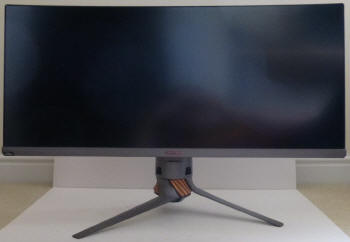
Above:
front views of the screen. Click for larger versions
The PG348Q comes in a silver "Armour
Titanium" and black design, with some "Plasma Copper" trim used in places
on the back and stand. The outer edge of the screen around the sides and
top is a frameless design, with a 2mm thick black plastic edge. There is
then an 11.5mm inner panel border so there's about 13.5mm around the top
and sides before the image starts. Along the bottom edge of the screen is
a thicker dark silver bezel with a shiny silver Asus logo in the middle.
This lower bezel is about 22mm thick and has a brushed aluminium style
finish to the plastic and some contouring to make it look pretty sleek.

The back of the screen is finished in a
matte black plastic, with patterned plastic (shown in the image below).
There are air vents dotted around to help with heat dissipation as well.
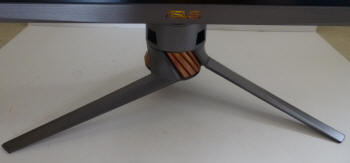
Above: view
of the base of the stand
The stand offers a sturdy three-pronged
aluminium base to help keep this heavy screen stable. There is some more
copper trim here on the base as shown above. The stand is quite deep at
about 300mm so you need to ensure you have a deep enough desk, otherwise
it might be too close to you. The dark titanium metal of the stand matches
the bottom bezel of the screen and looks attractive.
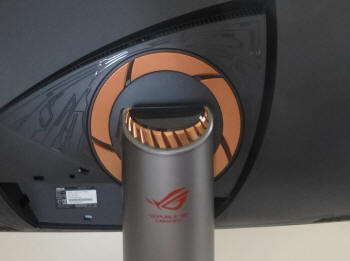
Above:
stand connection and copper trim on the back of the screen
The stand attaches to the back of the screen
as above, with more copper coloured trim used for contrast. This can also
be removed to reveal VESA 100mm mounting holes if needed.


Above:
light in motion ROG projection
The screen features a light system which is
built in to the bottom of the monitor arm. When turned on via the OSD menu
(the "Light in Motion" option) it projects a red Republic of Gamers logo
on to your desk which looks pretty cool. You can change the brightness of
this but not the colour. It obviously doesn't do much, but it's a nice
showy extra.
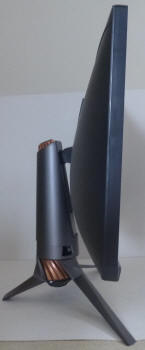
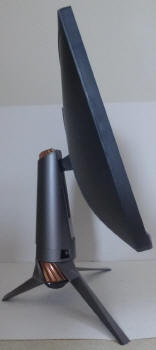
Above: full
tilt adjustment range
The stand offers tilt, height and swivel
adjustments. Rotation is not provided as it would be impractical on a
screen this format and size. The tilt function is stiff and quite hard to
move. It offers a reasonable range of angles though as shown above, but
given the stiffness you probably won't want to move it around too much if
you can help it.
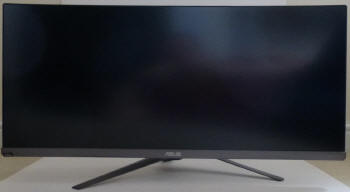
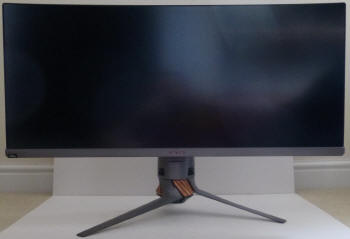
Above: full
height adjustment range
The height adjustment is a bit easier to
move and offers a smooth adjustment up and down. At the lowest setting the
bottom edge of the screen is 70mm from the top of the desk, and at full
extension it is 185mm. This gives a 115mm adjustment range as advertised.
Side to side swivel is fairly easy to move as well and smooth, so it's
really just the tilt which is a bit too stiff.
A summary of the screens ergonomic adjustments
is shown below:
|
Function |
Range |
Smoothness |
Ease of Use |
|
Tilt |
Yes |
Smooth |
Stiff |
|
Height |
115mm |
Smooth |
Moderate |
|
Swivel |
Yes |
Smooth |
Moderate |
|
Rotate |
n/a |
- |
- |
|
Overall |
Reasonable range of
adjustments offered, although tilt is stiff to move. |
The materials were of a high quality and the
build quality felt good as well. The whole screen remained
cool even during prolonged use which was pleasing. There was no audible noise or buzzing from the screen, even at the overclocked refresh rates
during normal uses and our few weeks of general testing. After some feedback
from a reader we did try some specific test pattern on the screen to see if
there was any coil whine introduced. At 95 and 100Hz overclocked refresh rates
some slight coil whine was evident if you listened to the screen closely. We
had not heard this at all during any other testing so whether it's truly an
issue to users is questionable. Certainly some test images might bring it
about but whether it's an issue during gaming or regular uses we don't know.
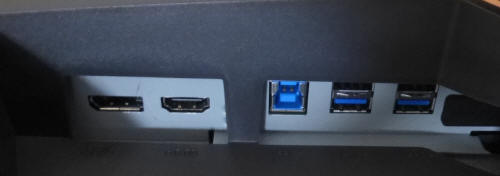
Above: rear
views of the screen showing connections.
The back of the screen provides the
video connections as shown above. There are only DisplayPort 1.2a and HDMI 1.4
inputs on this model given the use of NVIDIA G-sync. With it being a G-sync V
II module, HDMI is at least provided to give you some further flexibility
which is nice. Only the DP can support the high refresh rates and G-sync
though. On the back there is also the USB upstream and 4x USB 3.0 downstream
ports. The power connection (external power brick provided) is located further
to the right and not shown above. It was actually a bit fiddly to get to and
find. There's a detachable black plastic section which you can attach to the
back of the screen to hide some of the connections and cables if you want.

OSD Menu
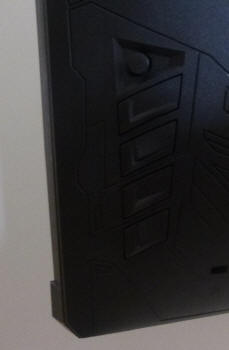
Above: OSD control buttons on the back right hand side of the screen (when
viewed from the front)
Click for
larger version
The OSD menu is accessed and controlled through 3
pressable buttons and a small joystick control located on the rear right hand
edge of the screen. There's also a power on/off button located here as well
which you have to be careful not to press accidentally when trying to use the
other buttons. Pressing the lowest button (above the power button) pops up the
turbo mode option straight away, allowing you to quickly and easily switch
between 60Hz and your maximum specified overclocked refresh rate up to 100Hz.
The button above that brings up the GamePlus menu with options for a crosshair,
timer or FPS counter overlay as we've seen on previous ROG Swift gaming screens.
To access the main OSD you have to press the
joystick button in. Navigation is then quick and easy with the joystick and it
makes the whole thing very intuitive.
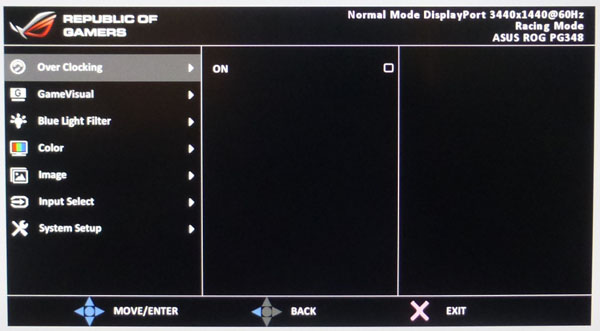
The menu is split in to 7 sections shown down the
left hand side, with options available in each then appearing on the right hand
side. The first section allows you to turn the interesting overclocking feature
on, and from there you can select your maximum overclocked refresh rate up to
100Hz. The screen it then rebooted and should load back up to your normal
desktop where that refresh rate becomes selectable in Windows in the normal way.
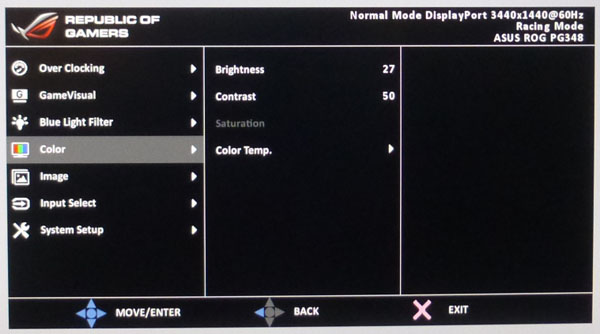
The menu then has options for the GameVisual
preset modes and Blue Light Filter levels. Below that, the 'color' section
offers useful controls over brightness, contrast and the colour temp setting
which will be needed for
calibration.
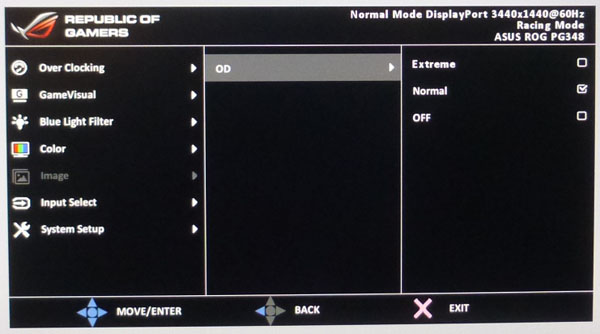
The image section has only one option in it for
the overdrive (OD) control as shown above. Maybe it would have been better to
group this in the same section as the overclocking feature, which is again on
its own.
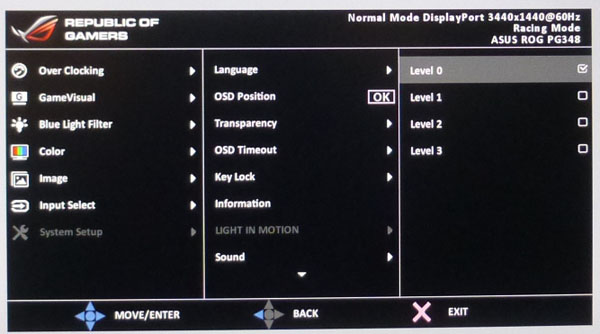
The input selection allows you to switch between
HDMI and DisplayPort inputs. It might have been useful to some people to have a
quick launch access to the input switch as you do have to drill through a few
menu button presses to get to it. The 'system setup' menu has a few options
relating to the OSD itself, but also the Light In Motion feature can be
controlled here, and the speaker volume.
Overall the menu was responsive, quick and easy to navigate
and we liked the joystick control. It might have been better to re-position a
few options and provide the ability to change the quick access options if the
user wanted to, but there were at least a decent range of settings to play with
here.

Power Consumption
In terms of power consumption the manufacturer
lists 'power on' usage of <100W (a little non-committal!), and 0.5W in standby. We carried out our normal tests to
establish its power consumption ourselves.
|
 |
|
State and Brightness
Setting |
Manufacturer Spec (W) |
Measured Power Usage
(W) |
|
Default (80%) |
<100.0 |
57.5 |
|
Calibrated (27%) |
- |
36.5 |
|
Maximum Brightness (100%) |
- |
65.6 |
|
Minimum Brightness (0%) |
- |
27.4 |
|
Standby |
0.5 |
0.5 |
|
We tested this ourselves and found that out of the
box the screen used 57.5W at the default 80% brightness setting. Once calibrated
the screen reached 36.5W consumption, and in standby it used only 0.5W. We have
plotted these results below compared with other screens we have tested. The
calibrated consumption is very similar to the Acer Predator X34 (40.6W) but a little
more than the Acer XR341CK FreeSync model (30.7W) and Dell U3415W (32.1W):


Panel and Backlighting
|
Panel Manufacturer |
LG.Display |
Colour Palette |
1.074 billion |
|
Panel Technology |
AH-IPS |
Colour Depth |
8-bit + FRC |
|
Panel Module |
LM340UW2-SSA1 |
Colour space |
Standard gamut |
|
Backlighting Type |
W-LED |
Colour space coverage (%) |
~sRGB, ~72% NTSC |
Panel Part and Colour Depth
The PG348Q features an
LG.Display LM340UW2-SSA1 AH-IPS panel which is capable of producing 1.074
billion colours. As we understand it the panel offers an 8-bit colour depth with
additional Frame Rate Control (FRC) stage added to support 10-bit content. Keep
in mind whether this is practically useable and whether you're ever going to
truly use that colour depth. You need to have a full 10-bit end to end
workflow to take advantage of it which is still quite expensive to achieve and
rare in the market, certainly for your average user. Especially when this is a
gaming screen and you're more likely to have a gaming graphics card than a
pro-grade 10-bit capable card connected. 10-bit support requires relevant
applications as well, so to many people this 10-bit support
might be irrelevant. The panel part is confirmed when dismantling the screen.
Incidentally this is the same panel we saw used in the
Acer Predator X34 /
XR341CK gaming screens and the
Dell U3415W display as
well.
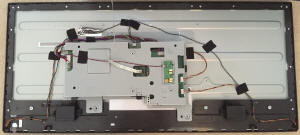
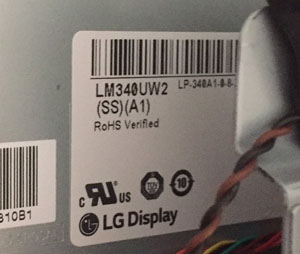
Screen
Coating
The
screen coating on the PG348Q is a light anti-glare (AG) offering, the
same as that featured on the Acer competing models as well. It isn't a semi-glossy
coating, but it is light as seen on other modern IPS type panels. Thankfully it
isn't a heavily grainy coating like some old IPS panels feature and is also
lighter than modern TN Film panel coating, including popular gaming screens. It
retains its anti-glare properties to avoid too many unwanted reflections of a
full glossy coating, but does not produce an too grainy or dirty an image that
some thicker AG coatings can. There were some very slight cross-hatching
patterns visible on the coating if you looked very closely, but nothing very
obvious.
Backlight Type and Colour Gamut
The screen uses a White-LED (W-LED) backlight unit
which has become very popular in today's market. This helps reduce power
consumption compared with older CCFL backlight units and brings about some
environmental benefits as well. The W-LED unit offers a standard colour gamut
which is approximately equal to the sRGB colour space.
Anyone wanting to work with wider colour spaces would need to consider wide
gamut CCFL screens or the newer range of GB-r-LED type displays available
now. If
you want to read more about colour spaces and gamut then please have a read of
our
detailed article.
Backlight
Dimming and Flicker
We tested the screen to establish the methods used
to control backlight dimming. Our in depth article talks in more details about a
common method used for this which is called
Pulse Width Modulation (PWM). This in itself gives cause for concern to some
users who have experienced eye strain, headaches and other symptoms as a result
of the flickering backlight caused by this technology. We use a photosensor +
oscilloscope system to measure backlight dimming control
with a high level of accuracy and ease. These tests allow us to establish
1) Whether PWM is being used to control the
backlight
2) The frequency and other characteristics at which this operates, if it is used
3) Whether a flicker may be introduced or potentially noticeable at certain
settings
If PWM is used for backlight dimming, the higher
the frequency, the less likely you are to see artefacts and flicker. The duty
cycle (the time for which the backlight is on) is also important and the shorter
the duty cycle, the more potential there is that you may see flicker. The other
factor which can influence flicker is the amplitude of the PWM, measuring the
difference in brightness output between the 'on' and 'off' states. Please
remember that not every user would notice a flicker from a backlight using PWM,
but it is something to be wary of. It is also a hard thing to quantify as it is
very subjective when talking about whether a user may or may not experience the
side effects.
100% 50%
0%



Above scale = 1
horizontal grid = 5ms
At 100% brightness a constant voltage is applied
to the backlight. As you reduce the brightness setting to dim the backlight a
Direct Current (DC) method is used, as opposed to any form of PWM. This applies
to all brightness settings from 100% down to 0%. The screen is flicker free as a
result, as advertised.
|
Pulse Width
Modulation Used |
No |
|
Cycling
Frequency |
n/a |
|
Possible
Flicker at |
|
|
100% Brightness |
No |
|
50% Brightness |
No |
|
0% Brightness |
No |
For an up to date list of all flicker-free (PWM free) monitors please see our
Flicker Free Monitor Database.

Contrast
Stability and Brightness
We wanted to see how much variance there was in
the screens contrast as we adjusted the monitor setting for brightness.
In theory, brightness and contrast are two independent parameters, and good
contrast is a requirement regardless of the brightness adjustment.
Unfortunately, such is not always the case in practice. We recorded the
screens luminance and black depth at various OSD brightness settings, and
calculated the contrast ratio from there. Graphics card settings were left at
default with no ICC profile or calibration active. Tests were made using an
X-rite i1 Display Pro colorimeter. It should be noted that we used the
BasICColor calibration software here to record these, and so luminance at
default settings may vary a little from the LaCie Blue Eye Pro report.
|
OSD
Brightness |
Luminance
(cd/m2) |
Black
Point (cd/m2) |
Contrast
Ratio
( x:1) |
|
100 |
340.97 |
0.31 |
1100 |
|
90 |
308.75 |
0.28 |
1103 |
|
80 |
279.44 |
0.25 |
1118 |
|
70 |
249.88 |
0.23 |
1086 |
|
60 |
220.21 |
0.20 |
1101 |
|
50 |
190.10 |
0.17 |
1118 |
|
40 |
159.64 |
0.15 |
1064 |
|
30 |
128.64 |
0.12 |
1072 |
|
20 |
97.14 |
0.09 |
1079 |
|
10 |
65.07 |
0.06 |
1084 |
|
0 |
32.97 |
0.03 |
1099 |
|
Total Luminance Adjustment Range
(cd/m2) |
308.00 |
Brightness OSD setting controls backlight |
 |
|
Total Black Point
Adjustment Range (cd/m2) |
0.28 |
|
Average Static Contrast Ratio |
1093:1 |
PWM Free |
 |
|
Recommended OSD setting
for 120 cd/m2 |
27 |
The brightness control gave us a very good range
of adjustment. At the top end the maximum luminance reached 341
cd/m2 which was
actually a fair bit brighter than the specified maximum brightness of 300 cd/m2
from the manufacturer. There was a decent 308 cd/m2 adjustment range
in total, and so at the minimum setting you could reach down to a very low
luminance of 33 cd/m2. This should be adequate for those wanting to
work in darkened room conditions with low ambient light. A setting of 27 in the OSD menu should return you a
luminance of around 120 cd/m2 at default settings.
It should be noted that the
brightness regulation is controlled without the need for
Pulse Width Modulation, using a Direct Current (DC) method for all
brightness settings between 100 and 0% and so the screen is flicker free as
advertised.

We have plotted the
luminance trend on the graph above. The screen behaves as it should in this
regard, with a reduction in the luminance output of the screen controlled by the
reduction in the OSD brightness setting. This is a linear relationship as you
can see.

The average contrast ratio of
the screen was very good for an IPS-type panel with an average of 1093:1. This
was nice and stable across the brightness adjustment range as shown above.

Testing
Methodology
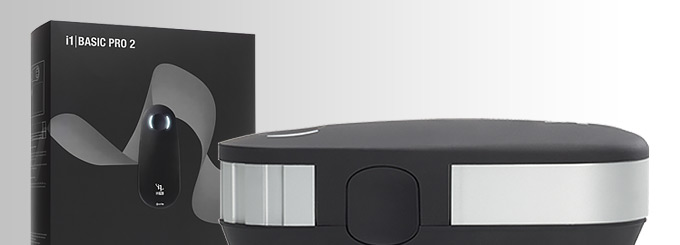
An
important thing to consider for most users is how a screen will perform out of
the box and with some basic manual adjustments. Since most users won't have
access to hardware colorimeter tools, it is important to understand how the
screen is going to perform in terms of colour accuracy for the average user.
We restored our graphics card to default settings
and disabled any previously active ICC profiles and gamma corrections. The
screen was tested at default factory settings using our new
X-rite i1
Pro 2 Spectrophotometer combined with
LaCie's Blue Eye Pro software suite. An X-rite i1 Display Pro colorimeter was
also used to verify the black point and contrast ratio since the i1 Pro 2
spectrophotometer is less
reliable at the darker end.
Targets for these tests are as follows:
-
CIE Diagram - validates the colour space
covered by the monitors backlighting in a 2D view, with the black triangle representing the
displays gamut, and other reference colour spaces shown for comparison
-
Gamma - we aim for 2.2 which is the default
for computer monitors
-
Colour temperature / white point - we aim
for 6500k which is the temperature of daylight
-
Luminance - we aim for 120
cd/m2, which is
the recommended luminance for LCD monitors in normal lighting conditions
-
Black depth - we aim
for as low as possible to maximise shadow detail and to offer us the best
contrast ratio
-
Contrast ratio - we aim
for as high as possible. Any dynamic contrast ratio controls are turned off here
if present
-
dE average / maximum -
as low as possible.
If DeltaE >3, the color displayed is significantly different from the
theoretical one, meaning that the difference will be perceptible to the
viewer.
If DeltaE <2, LaCie considers the calibration a success; there remains a
slight difference, but it is barely undetectable.
If DeltaE < 1, the color fidelity is excellent.

Default Performance and
Setup
Default settings of the screen were as follows:
|
Monitor OSD Option |
Default Settings |
|
Preset |
Racing Mode |
|
Brightness |
80 |
|
Contrast |
50 |
|
Colour Temp |
User Mode |
|
RGB |
100, 100, 100 |
|
Blue Light Filter |
0 |

Asus ROG Swift PG348Q - Default Settings




|
|
Default Settings |
|
luminance (cd/m2) |
296 |
|
Black Point (cd/m2) |
0.26 |
|
Contrast Ratio |
1120:1 |
Initially out of the box the screen was set in the
default 'Racing mode' preset. The colour temp setting was on the 'user mode' as
well with RGB channels all available but set at 100% each to start with. You could tell the screen was using a
standard gamut backlight and the image looked pretty good, but too bright for
comfortable use. Colour balance felt good although a little warm, and the image quality was decent. We went ahead and measured the default state with
the i1 Pro.
The
CIE diagram on the left of the image confirms that the monitors colour gamut
(black triangle) is roughly equal to
the sRGB colour space. There is some minor over-coverage, mostly in blue and
green shades but not by anything significant.
Default gamma was recorded at 2.2 average, leaving it with a 0% deviance
from the target which was excellent news, especially since the OSD menu does not
offer any gamma adjustment settings. White point was measured at 6107k being
slightly too warm from the target of 6500k but with a low 6% deviance. The
screen was set in the default 'user mode' colour temp mode incidentally. We
again tested the other modes which returned the following colour temperature
results:
Colour Temperature Modes
|
OSD option |
Measured white point |
|
Cool |
8508k |
|
Normal |
6948k |
|
Warm |
5977k |
|
User Mode |
6134k |
The white point was probably best at the default
'user mode' out of the box, and closest to our target of 6500k. It does also give you access to the RGB channels to calibrate the screen
yourself which should allow for fairly simple correction of that colour
temperature, as shown in the calibration section that follows. Luminance
was recorded at a very bright 296
cd/m2 which is
too high for prolonged general use. The screen was set at a default 80%
brightness in the OSD menu but that is easy to change of course to reach a more
comfortable setting without impacting any other aspect of the setup. The black
depth was 0.26 cd/m2 at this default
brightness setting, giving us a very good static contrast ratio
(for an IPS-type panel) of
1120:1.
Colour accuracy was also good out of the box
with a default dE average of 2.4, and a maximum of 5.7. Testing the screen
with colour gradients revealed smooth
gradients with some minor gradation evident in darker tones as you see from most
screens.

Calibration
We used the
X-rite i1 Pro 2
Spectrophotometer combined with the LaCie Blue Eye Pro software package to
achieve these results and reports. An X-rite i1 Display Pro colorimeter was used
to validate the black depth and contrast ratios due to lower end limitations of
the i1 Pro device.
|
Monitor OSD Option |
Calibrated OSD settings |
|
Preset |
Racing Mode |
|
Brightness |
27 |
|
Contrast |
50 |
|
Colour Temp |
User Mode |
|
RGB |
97, 99, 100 |
|
Blue Light Filter |
0 |

Asus ROG Swift PG348Q - Calibrated Settings

|
|
Calibrated Settings |
|
luminance (cd/m2) |
119 |
|
Black Point (cd/m2) |
0.11 |
|
Contrast Ratio |
1090:1 |
All the OSD
changes listed above allowed us to obtain an
optimum hardware starting point and setup before software level changes would be
made at the graphics card level. We left the LaCie software to calibrate
to "max" brightness which would just retain the luminance of whatever brightness
we'd set the screen to, and would not in any way try and alter the luminance at
the graphics card level, which can reduce contrast ratio. These adjustments
before profiling the screen would help preserve tonal values and limit
banding issues. After this we let the software carry out the LUT adjustments and create an
ICC profile.
Average gamma was maintained at the accurate 2.2 average
we had seen out of the box and no real adjustment was needed there. The
white point had been nicely corrected thanks to the adjustments to the RGB levels. It was
measured now at an accurate 6490k
(<0.5% deviance). Luminance had been improved thanks to the adjustment to the
brightness control and was now being measured at 119
cd/m2. This
left us a black depth of 0.11 cd/m2 and maintained a very good static contrast ratio
(for an IPS-type panel) of
1090:1. Colour accuracy of the resulting
profile was very good with dE average of 0.5 and maximum of only 1.6.
Testing the screen with colour gradients revealed smooth gradients with some minor gradation evident in
darker tones as you see from most screens.
You can use our settings and
try our calibrated ICC profile if you wish, which are available in
our ICC profile database. Keep in mind that results will vary from one
screen to another and from one computer / graphics card to another.

Calibration Performance Comparisons

The comparisons made in this section try to give
you a better view of how each screen performs, particularly out of the box which
is what is going to matter to most consumers. When comparing the default factory
settings for each monitor it is important to take into account several
measurement areas - gamma, white point and colour accuracy. There's no point
having a low dE colour accuracy figure if the gamma curve is way off for
instance. A good factory calibration requires all 3 to be well set up. We have
deliberately not included luminance in this comparison since this is normally
far too high by default on every screen. However, that is very easily controlled
through the brightness setting (on most screens) and should not impact the other
areas being measured anyway. It is easy enough to obtain a suitable luminance
for your working conditions and individual preferences, but a reliable factory
setup in gamma, white point and colour accuracy is important and not as easy to
change accurately without a calibration tool.
From these comparisons we can also compare the
calibrated colour accuracy, black depth and contrast ratio. After a calibration
the gamma, white point and luminance should all be at their desired targets.

Default setup of the screen out of the box was
very good overall, with an accurate gamma curve and low dE. White point was slightly too
warm but only by a minor 6%
deviance, and contrast ratio was strong for an IPS panel. Some basic OSD
adjustments to the RGB channels can correct that white point and you're good to
go!


The display was strong when it came to black depth
and contrast ratio for an IPS panel. With a calibrated contrast ratio of 1090:1
it was comparable to some of the better screens using this kind of panel
technology. It was not quite as high as the 25"
Dell U2515H
(1138:1 - not shown here) which holds the record for an IPS contrast ratio. It
was very similar though to the Acer Predator X34 (1033:1) and Dell U3415W
(1091:1) which share the same LG.Display panel. Of
course none of these IPS screens can compete with VA panel types which can reach
up to around 3000:1 easily
like the 35"
Acer Predator Z35 (2813:1), and
even close to 5000:1 in the case of the 24"
Eizo FG2421 (4845:1).
|
Check Pricing and Buy - Direct Links
|
|
Amazon USA |
Amazon
UK |
Overclockers UK |
Amazon GER |
Amazon CAN
|
|
TFTCentral is a participant
in the Amazon Services LLC Associates Programme, an affiliate
advertising programme designed to provide a means for sites to earn
advertising fees by advertising and linking to Amazon.com, Amazon.co.uk,
Amazon.de, Amazon.ca and other Amazon stores worldwide. We also
participate in a similar scheme for Overclockers.co.uk. |

Viewing Angles
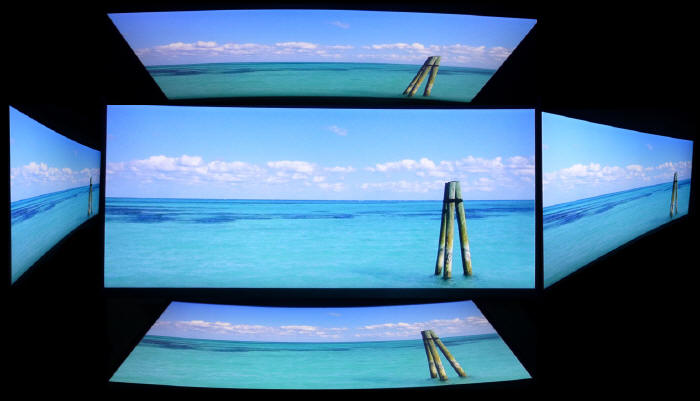
Above: Viewing
angles shown from front and side, and from above and below. Click for
larger image
Viewing angles of the screen were very good as you
would expect from an IPS panel. Horizontally there was very little colour tone
shift until wide angles past about 45°. A slight darkening of the image occurred
horizontally from wider angles as you can see above as the contrast shifted
slighting. Contrast shifts were slightly more noticeable in the vertical field
but overall they were very good. The screen offered the wide viewing angles of
IPS technology and was free from the restrictive fields of view of TN Film
panels, especially in the vertical plane. It was also free of the off-centre
contrast shift you see from VA panels and a lot of the quite obvious gamma and
colour tone shift you see from some of the modern VA panel type offerings. All
as expected really from a modern IPS panel. For a gaming screen, this is one of
the big positives of using IPS panel technology as opposed to the common TN Film
matrices which are generally adopted in gaming displays.
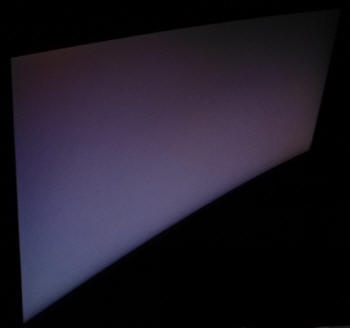
Above: View of an
all black screen from the side. Click for larger version
On a black image there is a characteristic pale
glow when viewed from an angle, commonly referred to as "IPS-glow". On the
PG348Q this actually appeared a little more purple in hue than the competing
Acer Predator X34 where it appeared more white. Odd given that it's the exact
same panel, but perhaps some variation in the panel coating here. This type of glow is
common on most modern IPS-type panels and can be distracting to some users. If
you view dark content from a normal head-on viewing position, you can actually
see this glow as your eyes look towards the edges of the screen. Because of the
sheer horizontal size of this 34" panel, the glow towards the edges is more
obvious than on small screens, where there isn't such a long distance from your
central position to the edges. Some people may find this problematic if they are
working with a lot of dark content or solid colour patterns. In normal day to
day uses, office work, movies and games you couldn't really notice this unless
you were viewing darker content. If you move your viewing position back, which
is probably likely for movies and games, the effect reduces as you do not have
such an extreme angle from your eye position to the screen edges. The glow
effect was a little less than on flat 34" ultra-wide screens as the curved
nature created a smaller angle between your eyes and the edges of the screen.

Panel Uniformity
We wanted to test
here how uniform the brightness was across the screen, as well as identify any
leakage from the backlight in dark lighting conditions. Measurements of the luminance
were taken at 36 points across the panel on a pure
white background. The measurements for luminance were taken using BasICColor's calibration
software package, combined with an X-rite i1 Display Pro
colorimeter with a central point on the screen calibrated to 120 cd/m2. The below uniformity diagram shows the difference, as a percentage,
between the measurement recorded at each point on the screen, as compared with the
central reference point.
It is worth
noting that panel uniformity can vary from one screen to another, and can depend
on manufacturing lines, screen transport and other local factors. This is only a
guide of the uniformity of the sample screen we have for review.

Uniformity of Luminance
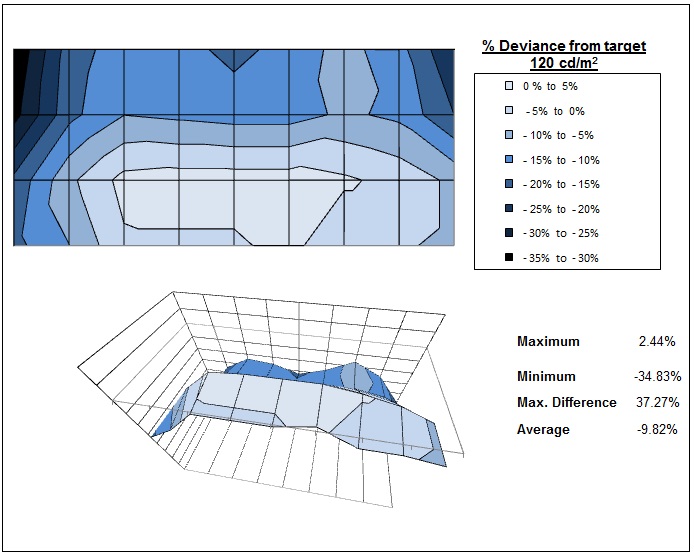
The luminance uniformity of the screen was
not great. The
top half of the screen was quite a bit darker than the bottom half
unfortunately, although in day to day normal use and multimedia you couldn't
really spot this. The luminance dropped by -35% down to 89 cd/m2
in the most extreme example in the upper left corner. The lower middle area
was more uniform and closer to the 120 cd/m2 calibrated central
point. Only 50% of the screen was within a 10% deviance threshold. Results
may vary from sample to sample of course, and as we've said, in gaming and
multimedia you don't really notice this variance day to day.

Backlight Leakage
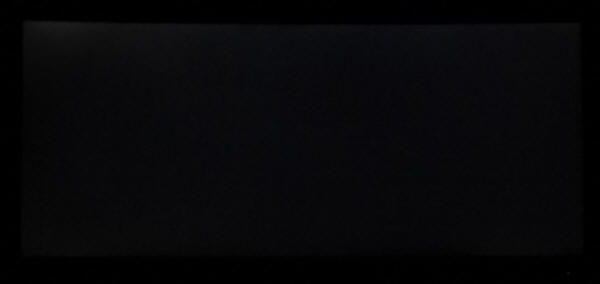
Above: All black screen in a darkened room. Click for larger version
As usual we also tested the screen with an all
black image and in a darkened room. A camera was used to capture the result. The
camera showed there was a very small amount of backlight bleed detected in the
top left corner but it was at a low level. There was no other obvious leakage of
clouding of the backlight here which was pleasing.
Note: if you want to test your own screen for
backlight bleed and uniformity problems at any point you need to ensure you have
suitable testing conditions. Set the monitor to a sensible day to day brightness
level, preferably as close to 120
cd/m2 as you can get it (our tests are
once the screen is calibrated to this luminance). Don't just take a photo at the
default brightness which is almost always far too high and not a realistic usage
condition. You need to take the photo from about 1.5 - 2m back to avoid
capturing viewing angle characteristics, especially on IPS-type panels where
off-angle glow can come in to play easily. Photos should be taken in a darkened
room at a shutter speed which captures what you see reliably and doesn't
over-expose the image. A shutter speed of 1/8 second will probably be suitable
for this.

General and Office Applications
One of the key selling points of ultra-wide
screens like the this is it's high resolution and large screen size. The 3440 x
1440 display offers a sharp but comfortable picture. Its pixel area is about 1.8
times larger than an Ultra-Wide Full HD 21:9 monitor, and about 2.4 times larger
than a Full HD 16:9 monitor. It provides an efficient environment in using
Microsoft Office programs showing 47 columns and 63 rows in excel. Thankfully
the high resolution is of a very comfortable size on the 34" panel, with a
0.2325mm pixel pitch is is very comparable to a 27" 2560 x 1440 monitor
(0.2331mm). This means you are basically getting a wider desktop to work with,
with a similar font size to a 27" model, and maintaining the same vertical
resolution as well. If you're coming from a lower resolution / larger pixel
pitch you may still find the fonts look quite small to start with, but like the
27" 1440p models out there you soon get used to it. Side by side multi-tasking
on this screen is excellent and you really do have a nice wide area to work
with. We liked the curved format of the display actually for day to day office
work. It just felt a bit more comfortable than a flat screen on a model as wide
as this, bringing the corners a bit nearer to you. You didn't really notice the
curve in normal use but we liked the feel. Probably down to user taste, so if in
doubt try and see one in person.
The light AG coating of the IPS panel doesn't
produce any graininess to the image like some aggressive AG solutions can and so
white office backgrounds look clean and clear. The wide viewing angles of the
IPS panel technology provide stable images from different angles, meaning you
can use the screen if you want for colour critical work, photos etc. It might be
orientated at gamers, but it's IPS panel can deliver strong performance in other
areas as well making it a good all-rounder. This panel technology still offers
the widest viewing angles and so is well-suited to colour work. Some contrast
shifts and IPS-glow may be evident because of the very wide size of the display,
as you glance towards the edges from a centrally aligned position. That's hard
to avoid on such a large desktop monitor from close up, even with IPS
technology.
The default setup of the screen was good and represented a decent setup for most
users. Some simple OSD tweaks can bring the white point closer to the target
which was really the only issue there. We were also pleased with the strong
1090:1 contrast ratio after calibration as well which was good for an IPS panel.
The brightness
range of the screen was also very good, with the ability to offer a luminance
between 341 and 33 cd/m2. This should mean the screen is perfectly
useable in a wide variety of ambient light conditions, including darkened rooms.
A setting of ~27 in the OSD brightness control should return you a luminance
close to 120 cd/m2 out of the box. On another positive note, the brightness
regulation is controlled without the need for the use of the now infamous
Pulse-Width Modulation (PWM), and so those who suffer from eye fatigue or
headaches associated with flickering backlights need not worry.
There was no audible noise whistling noise from the screen if you listened very
closely, even when using the full overclocked 100Hz refresh rate. There is talk
online about "coil whine" from screens when they are overclocked in some cases,
but we saw - or rather heard - no evidence of that here on our test system
during any normal day to day use over the few weeks of testing the screen. We
found we could introduce some coil whine at 95 and 100Hz using specific test
patterns but as we said earlier, it's questionable whether you'd ever experience
this in normal uses. The screen also remains fairly cool even during prolonged use.
There is no specific preset mode for office work or reading so you will have to
set one of the other modes how you want. With 6 preset modes available to change
and save, you can easily set others up if you need for different gaming
situations. Even with the use of G-sync v II, the screen is limited when it
comes to connectivity options with only DP and HDMI available. Picture in
Picture and Picture by Picture options are not provided on this model as a
result of the G-sync module and the inability to add a scaler to the screen as a
result.
The screen offers 4x USB 3.0 ports which can be
useful and it was nice to keep this up to date with the modern version. They are
all located on the back of the display so
are not easy-access really. Integrated 2x 2W RMS speakers can provide sound for the odd
YouTube clip or mp3 if you want. There are no further extras like ambient light
sensors or card readers which can be useful in office environments. Remember,
this is aimed at gamers really. There was a decent range of ergonomic adjustments
available from the stand allowing you to obtain a comfortable position for a
wide variety of angles. They were mostly stiff though so you might not
want to move it around too often. The VESA
mounting support may also be useful to some people as well for more flexibility.

Above: photo of
text at 3440 x 1440 (top) and 2560 x 1080 (bottom)
The screen is designed to run at its native
resolution of 3440 x 1440 and at a 60Hz native refresh rate. However,
if you want you are able to run the screen outside of this resolution. We tested
the screen at a lower 2560 x 1080 resolution to see how the screen handles the
interpolation of the resolution, while maintaining the same aspect ratio of
21:9. At native resolution the text was very sharp and clear. When running at a 1080p resolution the text is still
reasonably clear, with moderate
levels of blurring. You do lose a lot of screen real-estate as well of course
but the image seems to be quite well interpolated if needed. May be handy for
some systems where outputting games at 3440 x 1440 @ 100Hz is a challenge.

Gaming Introduction

The new ROG Swift PG348Q ultra-wide screen is
clearly gamer-orientated, pairing an ultra-wide format curved display with a
few gaming enhancements to deliver an interesting option for gamers.
Firstly we should consider the format of the screen, with the 34" area offering
a nice immersive experience and the wide 21:9 aspect proving popular for many
gamers since it was introduced. It's nice also that the screen offers the full
3440 x 1440 resolution currently available on models this size, as opposed to
the more limited 2560 x 1080 some 34" models have. That extra resolution
provides a clarity boost for all uses, including gaming. It does add some
additional demand on to your system and graphics card of course, but at least
there is also G-sync (discussed in a moment) to help with varying frame rate
outputs. Or if you really need to you can switch down to 2560 x 1080 anyway, and
we've seen the image is quite well interpolated. The slight curve to the screen
also adds to immersion feeling in games and we prefer it to flat 34" ultra-wide
models certainly.
At the moment the 34" monitor space is a little
limited by the panels being manufactured. At the moment only LG.Display and
Samsung seem to be investing in this format, with nothing reported in the
roadmaps for other main manufacturers like AU Optronics or Innolux. There's
really only the choice for display manufacturers between LG.Display's IPS, and
Samsung SVA panels. That's not necessarily a bad thing as IPS is always very
popular with buyers and using an IPS panel like Asus have here, does allow them
to offer a screen suitable for a wide range of uses, not just exclusively for
gaming. There are no TN Film panels in this size and format at the moment so the
IPS option is about as good as you can get at the moment for gaming needs.
Unfortunately, IPS is somewhat limited in what it can offer. This isn't a fault
of Asus, they are only working with what panels they have available to them
and making the most of them. IPS technology (and Samsung SVA for that matter) is
still fairly limited when it comes to pixel response times. It can't compete
with the speed of TN Film panels, and as yet LG.Display haven't found a way to
drive response times lower like AU Optronics have with their recent high refresh
rate AHVA (IPS-type) panels in the 27" space (e.g. the
Asus ROG Swift PG279Q). Still, people have been using IPS
for many years for gaming so there's no reason to think that a screen like this
couldn't be used as long as the response times are handled right. We will look
at that in the next section but we've seen positive things already from the Acer
equivalents. Sure, they won't be quite as fast as TN Film
panels, but they are still fine for many users. The availability of TN Film
panels in this format would have given Asus more choice perhaps, and the ability
to offer an even better gaming experience. Although we expect people would only
then moan about the restrictions of TN Film for other uses.
This leads us on to refresh rate. Again Asus are
limited here by what is available panel-wise. LG.Display have yet to release any
native high refresh rate (144Hz) IPS panel in any size. They had a 27" 1080p
panel expected in Q3 last year but it's not emerged yet and perhaps indicates
they are still in development or have perhaps been scrapped in favour of
investment elsewhere. Response times are likely to be the limiting factor in their quest, as
they need to be able to reliably drive them under 6.94ms average (without loads
of overshoot) to make 144Hz viable. That aside, an even bigger problem is that the 3440 x
1440 resolution offered on a screen this size is too high to run at 144Hz with
current DisplayPort standards. We would need to see DisplayPort 1.3 for that
kind of bandwidth to be viable which isn't expected on graphics cards until
later this year. All in all, it's likely to be a fair amount of
time before we see a 144Hz native 3440 x 1440 screen sadly. In the mean time,
Asus have done what they can with the available panel, within the confines of
what it will support from an overclocked refresh rate point of view.
Boosted Refresh Rates
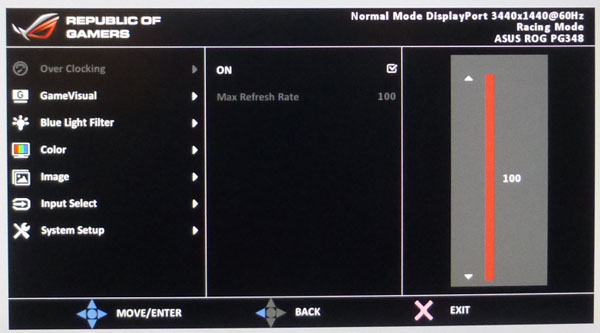
The panel being used here is a
native 60Hz panel, but Asus have built in an "overclocking" feature which allows
the user to reach up to 100Hz refresh rate maximum. This can be easily enabled
via the OSD menu using the 'Over clocking' section. You toggle the option on and
then you can select a maximum refresh rate setting from 75 to 100Hz in 5Hz
steps. Once you've selected your maximum refresh rate you press enter and the
screen reboots. From there, you should be able to go in to Windows or your
graphics card settings as normal and
change your selected refresh rate up to whatever you choose as the maximum,
again in 5Hz steps above 75Hz. The
reason for the steps from 75 to 100Hz to accommodate people who perhaps don't
have a powerful enough system for the maximum setting and want to cap the upper
limit lower. Asus also recommend you are using a G-sync capable card from NVIDIA
which would be logical since you're paying a fair chunk of money for the
privilege of having G-sync available. Those cards should apparently handle the
overclock up to 100Hz although a GTX 980 Ti or above is recommended for optimum
performance apparently.
We will test these higher refresh rates during the
following sections of this review, checking if any frames are dropped and if
there appear to be any side effects. One other note is that the Turbo key on the
right hand side of the screen with the menu controls can be used to quickly
switch between 60Hz and 100Hz (once you've enabled the overclock) if you want.
This higher refresh rate support has
been paired with an
NVIDIA G-sync module, offering G-sync variable refresh rate support between
30 and 100Hz. The overclocking facility of the screen seems to be related to the
presence of a G-sync module, or perhaps more precisely down to the absence of a
built-in scaler. Other overclockable screens we've tested so far like the
Asus ROG Swift PG279Q @ 165Hz and
Acer Predator Z35 @ 200Hz are also G-sync capable so that seems to be the
key here. With G-sync being provided you can run the screen potentially at the
maximum 3440 x 1440 @ 100Hz but know that the refresh rate will be dynamically
controlled to avoid tearing and stuttering by the G-sync module if needed.
G-sync is certainly a very useful feature and very important on high
resolution/high refresh rate gaming screens now.
Additional Gaming Features - Where is ULMB?
Sadly one thing which is missing from the PG348Q is a
Blur Reduction mode. We were hoping ULMB would be available as part of the
G-sync module, and some early press reports and specs suggested it would be
featured here but it has not been provided. Presumably that has something
to do with the refresh rate range, as providing ULMB at lower refresh rates
<85Hz is generally considered too flickery, and since the higher refresh rates
are not guaranteed here it was probably too much to ask for. NVIDIA 3D Vision is
also not supported, as that needs refresh rates of 120Hz minimum to function
correctly (60Hz per eye in active shutter mode).
|
Ultra Wide screen format |
 |
|
IPS-type panel technology |
 |
|
Max refresh rate support
|
Up to 100Hz |
|
G-sync support |
 |
|
Blur Reduction mode |
 |
|
NVIDIA 3D Vision |
 |

Responsiveness and Gaming
|
Quoted G2G Response Time |
4ms G2G |
|
Quoted ISO Response Time |
n/a |
|
Panel Manufacturer and
Technology |
LG.Display AH-IPS |
|
Panel Part |
LM340UW2-SSA1 |
|
Overdrive Used |
Yes |
|
Overdrive Control Available to
User |
OD |
|
Overdrive Settings |
Off, Normal, Extreme |
The ROG Swift PG348Q is rated by Asus as having a 4ms G2G response time, which indicates the panel uses
overdrive /
response time compensation (RTC) technology to boost pixel transitions
across grey to grey changes. There is user control over the overdrive impulse
within the OSD menu using the 'OD' (overdrive) option. The
part
being used is the
LG.Display AH-IPS LM340UW2-SSA1 panel, the exact same panel as
already used in the Acer Predator X34 and Dell U3415W displays. Have a read about response time in
our
specs section if you need additional information about this measurement.
We will first test the screen using our thorough
response time testing method. This uses an oscilloscope and photosensor to
measure the pixel response times across a series of different transitions, in
the full range from 0 (black) to 255 (white). This will give us a realistic view
of how the monitor performs in real life, as opposed to being reliant only on a
manufacturers spec. We can work out the response times for changing between many
different shades, calculate the maximum, minimum and average grey
to grey (G2G) response times, and provide an evaluation of any overshoot present
on the monitor.
We use an
ETC M526
oscilloscope for these measurements along with a custom photosensor device.
Have a read of
our response time measurement article for a full explanation of the testing methodology and reported
data.
Response Time Setting Comparison

The PG348Q comes with a user control for the
overdrive impulse available within the OSD menu in the 'image' section. There are 3 options available here under the
OD setting. First of all we carried out a fairly small set
of measurements in all 3 of the OD settings. These, along with various motion
tests allowed us to quickly identify which was the optimum overdrive setting for
this screen. Note that for now we have stuck with the native 60Hz refresh rate
of the panel. These tests are just designed to help us identify the optimal OD
setting, and we will check the response times again when we come to overclock
the refresh rate.

Firstly we tested the response times with OD set to
off, effectively turning off the overdrive impulse. The average
response time was measured at 13.4ms G2G average which was actually not
that slow, but certainly not optimum for this technology. Rise times were
quite a bit slower than fall times and there was
some obvious blurring to moving images. There was no overshoot in this mode
since OD was turned off, but we would hope for better responsiveness from the
other modes.

Switching up to the 'Normal' OD setting brought about
some positive changes to response times. G2G average had reduced down to 10.1ms
now which was better, but a little slower than the best case 60Hz IPS
panels around, which can reach down to around 8.6ms G2G without introducing
noticeable amounts of overshoot. We had perhaps hoped for a little faster here
with a slightly more aggressive overdrive impulse perhaps to push response times
down nearer that figure. Remember that this small sample set was at 60Hz
refresh rate so we may see some improvement when we switch up to the overclocked
refresh rates in a moment. There was still no overshoot at all in this mode,
suggesting that perhaps the overdrive impulse could be pushed a little further perhaps to boost
response times.

Finally we tested the 'Extreme' OD setting. There was
an improvement in measured response times down to 7.5ms G2G average but at the cost of some very high overshoot, which was obvious and distracting
during actual use. Stick with the 'normal' OD mode for optimal performance.

We can also make some visual comparisons of the
three OD settings using the moving images of the PixPerAn tool. The above photos
were captured in each of the OD modes. With OD off, there was a fairly obvious
blurring to the moving image, something that was largely eliminated when
switching up to the 'normal' mode. It wasn't quite as clear as some other IPS
panels we've tested, particularly those with high refresh rates but it was
certainly a sharper and clearer image than with OD off. There were no signs of overshoot either in this mode
which was pleasing. The 'extreme' mode pushed things too far, and
dark overshoot trails were introduced as you can see. Stick with the
normal mode for optimal performance.

Refresh Rate

One of the most interesting features of the PG348Q is
the overclockable refresh rate. The panel itself is designed to run at 60Hz by
LG.Display and that's the native refresh rate you will be able to select in
Windows when you first connect the screen. However, there is a specific feature
available in the OSD menu in the 'over clocking' section as shown above. This
allows you to enable the higher refresh rate support. We've already talked about
this support in more detail in the
gaming
introduction section.
We had no issues with selecting and running the
screen at any of these
refresh rates from our tests system, using an NVIDIA GTX 750 graphics card. All
of them worked fine in Windows with no visible artefacts or flickering. Some
users have reported some coil whine from other overclockable screens (it's very
early days for this particular model) when using overclocked
refresh rates but we heard nothing different at any refresh rate. If you do have a really obvious
whine from the screen which is an issue for you, we would suggest contacting
Asus or the retailer for an RMA as that doesn't seem to be an issue affecting every sample.
Certainly ours was fine. From the NVIDIA GTX 750 card we tested
the screen using the
BlurBusters.com frame skipping test and found that the screen did seem to
drop frames at all refresh rates, including the native 60Hz. Perhaps the card is
not powerful enough for this screen or isn't fully compatible. Asus recommend a
GTX 980 Ti or higher and so we tried one of those as well.
With an NVIDIA GTX 980 card we found no issues
with running the screen at any refresh rate between 60 and 100Hz. The image was
stable and there was no flicker or coil whine. Thankfully with this card we saw
no frame skipping at any refresh rate, all the way up to the maximum 100Hz. Asus
recommend a high end NVIDIA card for use with this screen so this is perhaps not
surprising, but something to keep in mind. This is very much a high end gaming
screen and so we expect a lot of potential users will have very advanced gaming
PC's to run it on anyway. You'd need something high end to power 3440 x 1440 @
100Hz.
We also tried the screen from an AMD Radeon R9 290 series graphics card
where we had
more trouble. You could select refresh rates all the way up to 100Hz
fine, but anything above 60Hz resulted in periodic flickering of the screen. It
seems the screen is perhaps more fussy from AMD systems when using the
overclocking feature, so stick with a high-end NVIDIA card for this model (which you
probably would given it's a G-sync model anyway). We found the competing Acer
Predator X34 less fussy when we tested it, which worked fine from our NVIDIA GTX
750 card and the AMD Radeon R9 290 series as well, without any flickering or frames being
dropped. It does seem the Asus is more fussy.
60Hz Refresh
Rate

100Hz Refresh
Rate

On another interesting note, we found that the
response times were improved when running at a higher refresh rate. We've seen
this from some other screens as well where response times are somewhat
influenced by the active refresh rate. Here, we saw a decent improvement in
response times when you compare them at 60Hz and at 100Hz. In both cases we were
using the optimal OD normal setting by the way. Pixel transitions improved down
to 7.7ms G2G with the 100Hz refresh rate, and it remained free of any overshoot
problems. A pleasing result, and some decent response times from an IPS-type
panel. With an average G2G of 7.7ms, it is suitably low enough to support the
100 fps frame rate available here, since the screen needs to refresh every 10ms.
When response times are slower than the refresh frequency excess blurring and
smearing can be introduced, but that's not a problem here on the
PG348Q. The
G-sync operating range is 30
- 100Hz maximum, depending on if you've used the overclocking feature which
gives you a nice wide range. Given the high resolution here, the G-sync support
combined with a wide dynamic range should provide a very pleasing gaming
experience. We ran
some G-sync tests which looked smooth and performed well.
One thing we did notice on our test systems was an
odd behaviour with the overdrive impulse at the maximum 100Hz refresh rate, and
also at one step down of 95Hz. If you observe the moving car in the PixPerAn
tests you can see this issue. Approximately every 10 seconds the overdrive
impulse seemed to "jump", causing a large amount of overshoot to momentarily
appear in front of the moving object, before quickly reverting to its normal
operation. It was a very quick change but you could see it clearly. At 100Hz and
with OD set to normal there is no overshoot trailing at all normally behind the
car. When this "jump" happens a noticeable and pretty severe dark and pale
overshoot appears in front of the car before reverting back to normal again and
going through the same cycle. It was an odd behaviour and we can only assume it
was an artefact resulting from the excessive refresh rate boost above the native
60Hz. At overclocked refresh rates between 60 and 90Hz this did not appear, so
it seemed to be only when pushing the screen to the limit of its refresh rate
overclock. We had seen something similar when we tested the
Acer Predator Z35 at its maximum 200Hz overclock setting.
Perhaps this will vary on other systems and
graphics cards although we found it did the exact same thing on both NVIDIA GTX
750 and 980 cards and our AMD Radeon system as well. We have fed this back to
Asus for testing and comment and will update this part of the review when we
have more information.
For now, we would recommend sticking with 90Hz as
the maximum overclock speed and refresh rate setting where this overdrive
anomaly is not present. You are still getting a 50% boost in refresh rate/frame
rates compared with the native 60Hz panel, and some nice additional benefits in
terms of improved response times and improved perceived motion blur. Powering
the screen at 3440 x 1440 and above 90Hz on a regular basis is probably going to
be a challenge in most games anyway, so we don't expect our 90Hz upper cap
recommendation to be a problem really.

More Detailed Measurements
OD Normal, 100Hz Refresh Rate
Having established that the OD normal setting
offered the best response/overshoot balance we carried out our normal wider
range of measurements as shown below. We used the maximum overclocked refresh
rate of 100Hz since that had been stable on our test system and delivered the
optimal response time performance.
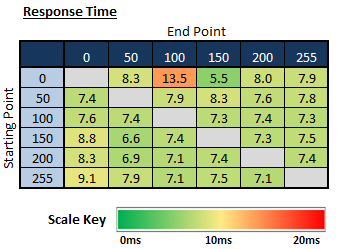 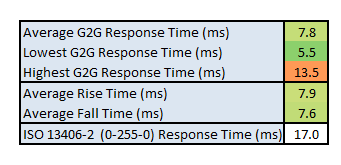
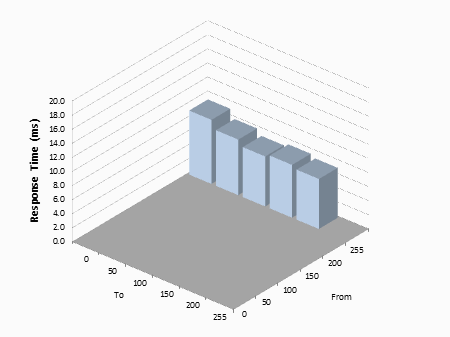
The average G2G response time was more accurately
measured at 7.8ms which was very good overall for an IPS-type panel.
Transitions were a little slower on rise times (changes from dark to light) but
not by anything significant. One transition (0-100) seemed to be a little slower
than everything else, measured at 13.5ms, where the overdrive impulse was perhaps
not quite as well tuned. Overall the response times were faster
than the best 60Hz IPS panels available at the moment, which can reach down to
about 8.6ms G2G average without overshoot. Here, the 100Hz overclocked refresh
rate helped push them a little lower which was pleasing.
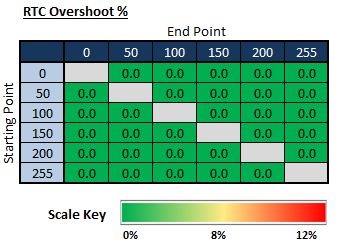
There was no overshoot at all on any
transition as long as you were using the maximum refresh rate. Having tested OD
normal at 60Hz there was also no overshoot detected there either.

Display Comparisons
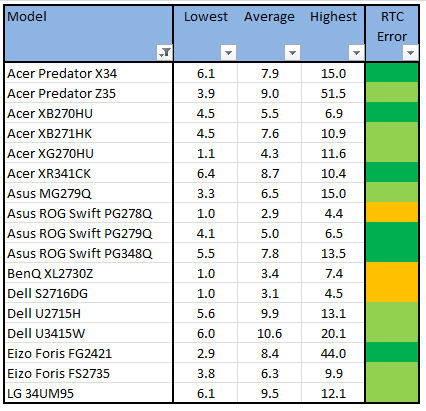
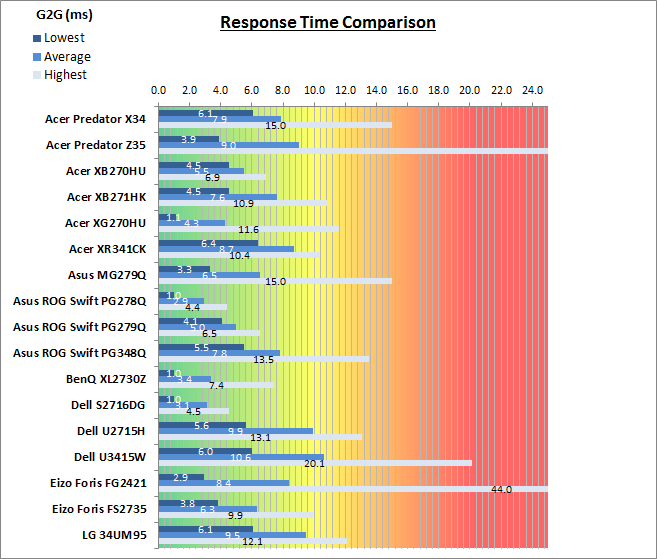
The above comparison table and graph shows you the
lowest, average and highest G2G response time measurement for each screen we
have tested with our oscilloscope system. There is also a colour coded mark next
to each screen in the table to indicate the RTC overshoot error, as the response
time figure alone doesn't tell the whole story.
When using the screen at the native 60Hz refresh
rate the response times (10.1ms G2G) were a bit slower than some of the
best 60Hz IPS-type panels available, which can reach down to ~8.6ms G2G while
remaining free of overshoot. When you push the refresh rate up to 100Hz the
response time are improved nicely, down to 7.8ms G2G which is impressive. There
is also no overshoot at all at this refresh rate as long as you stick to the
'normal' OD mode. This left the screen as being basically the same as the Acer
Predator X34 (7.9ms) and slightly faster than the FreeSync Acer XR341CK
(8.7ms) because that model had a lower maximum 75Hz refresh rate. The ROG Swift
PG348Q was also quite
a bit faster than the other 34" widescreen displays we've tested like the Dell
U3415W (10.6ms G2G) and LG 34UM95 (9.5ms G2G), again thanks to the faster
refresh rate. Very pleasing performance really
when it comes to pixel response times.
The screen was also tested using the chase test in
PixPerAn for the following display comparisons. As a reminder, a series of
pictures are taken on the highest shutter speed and compared, with the best case
example shown on the left, and worst case example on the right. This should only
be used as a rough guide to comparative responsiveness but is handy for a
comparison between different screens and technologies as well as a means to
compare those screens we tested before the introduction of our oscilloscope
method.

34"
4ms
G2G LG.Display AH-IPS @ 100Hz (OD = Normal)
In practice the Asus ROG Swift PG348Q performed best with
OD at normal. There were low levels of blurring evident, the image looked sharp
and there was no overshoot at all. The support for higher refresh rates up to
100Hz provided additional levels of motion clarity and image smoothness which
surpassed what was possible from 60Hz panels. The additional G-sync support for
NVIDIA users will also be of real benefit.

34"
4ms
G2G LG.Display AH-IPS @ 100Hz (OD = Normal)

34"
4ms
G2G LG.Display AH-IPS @ 100Hz (OD = Normal)

34"
4ms
G2G LG.Display AH-IPS @ 75Hz (OD = Normal)

34"
8ms
G2G LG.Display AH-IPS (Response Time = Normal)

34"
5ms
G2G LG.Display AH-IPS (Response Time = Middle)
The above images show a comparison first of all with the
most direct competitor, the
Acer Predator X34. That model performed very similarly which is not
surprising since they are both using the same exact panel, and our response time
measurements revealed almost identical overall performance.
Acer XR341CK model (FreeSync version) along with the other two
other 34" ultra-wide screens we've tested are also then shown. The PG348Q with its faster response
times and higher refresh rate was a bit better than the Acer XR341CK with a
less noticeable blurring. The
Dell U3415W featured the exact
same panel as the Asus/Acer screens but was a little slower than both in practice we felt. Our
oscilloscope measurements also confirmed slower response times on the Dell, and
some low levels of overshoot which the Acer did not have. The LG was pretty
similar to them all as well although slightly slower again than the Acer/Asus
overclocked models. The
PG348Q and X34 definitely have the edge here over the other ultra-wide models, largely thanks to
their overclocked 100Hz
refresh rates.

Additional Gaming Features

1) Turbo key -
You can select
your preferred refresh rate with a turbo key to toggle refresh rates on the
fly without needing to access the graphics driver control panel. You can
quickly select from 60 or 100Hz (or whatever max overclocked refresh rate
you've set up). This may be handy while in the middle of a game to match the
different frame rates of different games to maintain smoothness. It can also
be used to lessen the load on your graphics card and CPU by setting a cap on
the Hz for different games.
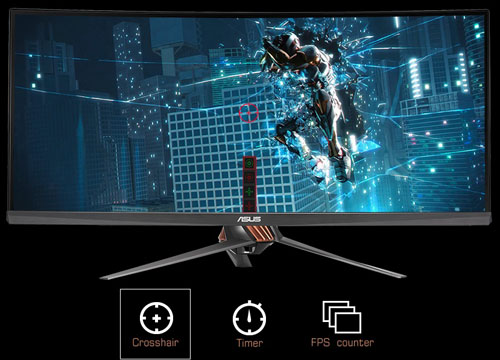
2) GamePlus
hotkey - the screen features the ASUS-exclusive GamePlus hotkey for
in-game enhancements so you get more out of your game. The crosshair overlay
gives you four different crosshair options to suit the game you're playing.
There's also an onscreen timer you can position on the left of the display so
you can keep track of the elapsed gaming time; while the FPS (frames per
second) counter lets you know how smooth the game is running.
3) Asus
GameVisual Technology - basically a series of pre-set display modes to
optimize visuals for different types of content. There are 6 in total although
some are not specifically designed for gaming per se. This feature can be
accessed through the On Screen Display (OSD) settings menu. There are preset
modes for scenery, racing, cinema, RTS/RPG games, FPS games and an sRGB mode.
4) Aspect Ratio Control - The PG348Q does
not offer any
aspect ratio control options through the OSD menu at all. This is due to a
limitation of using NVIDIA's G-sync technology. As we understand it, it is
locked to only one defined resolution, in this case 3440 x 1440 so it is not
possible (or easy) to provide G-sync support with a scaler. This isn't really
a problem for PC use since you can just control the aspect ratio through your
graphics card settings. It could be an issue perhaps where a lot of content is
16:9 aspect natively and the screen is obviously 21:9 ultra-wide.

Lag
We have written an in depth article about
input lag and the various measurement techniques which are used to evaluate
this aspect of a display. It's important to first of all understand the
different methods available and also what this lag means to you as an end-user.
Input Lag vs. Display Lag vs. Signal
Processing
To avoid confusion with different terminology we
will refer to this section of our reviews as just "lag" from now on, as there
are a few different aspects to consider, and different interpretations of the
term "input lag". We will consider the following points here as much as
possible. The overall "display lag" is the first, that being the delay between
the image being shown on the TFT display and that being shown on a CRT. This is
what many people will know as input lag and originally was the measure made to
explain why the image is a little behind when using a CRT. The older stopwatch
based methods were the common way to measure this in the past, but through
advanced studies have been shown to be quite inaccurate. As a result, more
advanced tools like SMTT provide a method to measure that delay between a TFT
and CRT while removing the inaccuracies of older stopwatch methods.
In reality that lag / delay is caused by a
combination of two things - the signal processing delay caused by the TFT
electronics / scaler, and the response time of the pixels themselves. Most
"input lag" measurements over the years have always been based on the overall
display lag (signal processing + response time) and indeed the SMTT tool is
based on this visual difference between a CRT and TFT and so measures the
overall display lag. In practice the signal processing is the element which
gives the feel of lag to the user, and the response time of course can
impact blurring, and overall image quality in moving scenes. As people become
more aware of lag as a possible issue, we are of course keen to try and
understand the split between the two as much as possible to give a complete
picture.
The signal processing element within that is quite
hard to identify without extremely high end equipment and very complicated
methods. In fact the studies by Thomas Thiemann which really kicked this whole
thing off were based on equipment worth >100,1000 Euro, requiring extremely high
bandwidths and very complicated methods to trigger the correct behaviour and
accurately measure the signal processing on its own. Other techniques which are
being used since are not conducted by Thomas (he is a freelance writer) or based
on this equipment or technique, and may also be subject to other errors or
inaccuracies based on our conversations with him since. It's very hard as a
result to produce a technique which will measure just the signal processing on
its own unfortunately. Many measurement techniques are also not explained and so
it is important to try and get a picture from various sources if possible to
make an informed judgement about a display overall.
For our tests we will continue to use the SMTT
tool to measure the overall "display lag". From there we can use our
oscilloscope system to measure the response time across a wide range of grey to
grey (G2G) transitions as recorded in our
response time
tests. Since SMTT will not include the full response time within its
measurements, after speaking with Thomas further about the situation we will
subtract half of the average G2G response time from the total display lag. This should allow us to give a good estimation of
how much of the overall lag is attributable to the signal processing element on
its own.
Lag Classification
To help in this section we will also introduce a broader classification system
for these results to help categorise each screen as one of the following levels:
-
Class 1)
Less than 16ms / 1 frame lag at 60Hz - should be fine for gamers, even at high levels
-
Class
2)
A lag of 16 -
32ms / One to two frames of lag at 60Hz - moderate lag but should be fine for many gamers.
Caution advised for serious gaming and FPS
-
Class
3)
A lag of more
than 32ms / more than 2 frames of lag at 60Hz - Some noticeable lag in daily usage, not
suitable for high end gaming
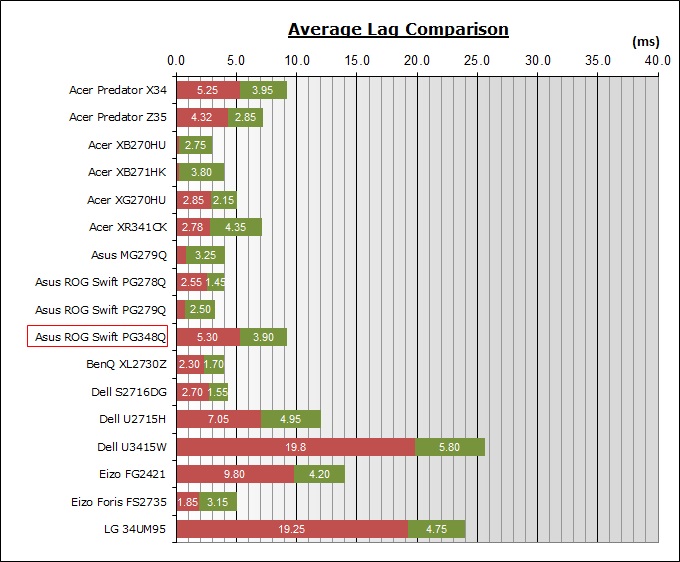
For the full reviews of the models compared here and the dates they were written
(and when screens were approximately released to the market), please see our
full
reviews index.
|
(Measurements in ms) |
|
|
Total Display Lag (SMTT
2) |
9.20 |
|
Pixel Response Time
Element |
3.90 |
|
Estimated Signal
Processing Lag |
5.30 |
|
Lag Classification |
1 |
|

Class 1 |
We have provided a comparison above against other
models we have tested to give an indication between screens. The screens
tested are split into two measurements which are
based on our overall display lag tests (using SMTT) and half the average G2G
response time, as measured by the oscilloscope. The response time is split from
the overall display lag and shown on the graph as the green bar. From there, the
signal processing (red bar) can be provided as a good estimation.
The screen showed a total lag of only 9.20ms.
Approximately 3.90ms of that can be accounted for by pixel response times,
leaving an estimated signal processing lag of only 5.30ms. This is basically
nothing and means the screen should be fine for all levels of gaming. Other
G-sync screens to date have shown similar very low levels of lag which is
pleasing. This was almost identical incidentally to the Acer Predator X34 which
is again not surprising. The Dell U3415W and LG 34UM95 ultrawide screens with
additional added scalers (and no G-sync module) show just over 1 frame of signal
processing lag.

Movies and Video

The following summarises the screens performance
in video applications:
-
34"
screen size makes it a good option for an all-in-one multimedia screen, and
pushing towards the diagonal size of a lot of smaller end LCD TV's even.
-
21:9
aspect ratio is well suited to videos and particularly movies, leaving smaller
borders on DVD's and wide screen content at the top and bottom. The ultra-wide
aspect and size is well-suited to watching movies and really works well.
-
3440 x
1440 resolution can support full 1080 HD resolution content.
-
Digital interfaces support HDCP for any encrypted and protected content
-
HDMI and DisplayPort connections available.
Nice to see HDMI connectivity included for modern DVD players, Blu-ray,
consoles etc thanks to the use of G-sync v II here.
-
Cables provided in the box
for HDMI and DisplayPort.
-
Light
AG coating provides clear images with no major graininess, and without the
unwanted reflections of a glossy solution.
-
Wide
brightness range adjustment possible from the display, including high maximum
luminance of 341
cd/m2 and a good minimum luminance of
33 cd/m2. This should afford you very good control for
different lighting conditions. Contrast ratio remains stable across most of
that adjustment range as well and is excellent for an IPS-type panel at
>1000:1. Brightness regulation is controlled without the need for PWM and so
is flicker free at all settings which is pleasing.
-
Black
depth and contrast ratio are very good for an IPS-type panel at 1090:1 after
calibration. Detail in darker scenes should not be lost as a result.
-
There
is a specific 'cinema' preset mode available for movies or video in the
OSD which is brighter and cooler than our calibrated mode. May be useful
though to set that mode up how you want for movies.
-
Very
good pixel responsiveness which can handle fast moving scenes in movies
without issue. No overshoot issues which is good news as well. Just stick to
the 'Normal' OD setting for optimum performance.
-
100Hz
refresh rate improves fluidity of moving images and reduces perceived blurring
to a degree.
-
Wide viewing angles from IPS panel technology
meaning several people could view the screen at once comfortable and from a
whole host of different angles. White IPS glow from an angle may be an issue
for some darker content.
-
Very
little backlight leakage on our sample which is good. Some uniformity
variations may be visible on darker movie scenes in darkened room conditions.
-
Pretty good range range of ergonomic adjustments
available from the stand, making it fairly easy to position the screen in
different ways for viewing from different positions. They were stiff to move
and the screen is heavy, so you won't want to move it around too often.
-
Integrated 2x 2W RMS sound stereo speakers offered on this model, may be ok for the odd
video clip but probably not for any movie viewing.
-
No
hardware aspect ratio control options available. Not a problem for PC movie
viewing but external devices may be an issue given differing aspect ratios.
-
Picture By Picture (PbP) and Picture In Picture (PiP) are not available on
this model.

Conclusion
The PG348Q is another great addition to the
already very popular and established ROG Swift gaming monitor series. Asus have
done a nice job with the design and build of this screen and it feels like a
premium high-end monitor worthy of the Republic of Gamers brand. We liked the
titanium silvers and copper sections and the added red light logo projection
looked fancy. Underneath that you get an established and proven panel and
obviously the ultra-wide format and high resolution are two of the key selling
points of models like this. You get a massive area to work with for every day
uses and an interesting (and increasingly popular) format for gaming.
Gaming is where this screen is firmly aimed of
course, although that's not to say it can't handle all-round uses very well. The
IPS panel offers a solid default setup, strong contrast ratio and wide viewing
angles that you'd hope for from this panel technology. Some might be distracted
by the IPS glow on dark content on a screen this size but that's a "feature" of
most current IPS panels. We appreciate the light AG coating and flicker free
backlight as well which are always positive. For the gaming target market Asus
have done a nice job providing some additional boosts. The 100Hz overclocked
refresh rate is one of the key features here and provided improved response
times, a big jump in frame rate support and improved motion clarity. We did find
the screen was quite fussy with graphics card support so make sure you have a
suitably powerful enough NVIDIA card to run it to avoid problems. To power a
screen with this resolution and refresh rate you're going to need something
beefy anyway. The additional G-sync support is of real value here, helping your
system handle the demands of the screen nicely and the presence of this also
ensured the input lag was extremely low. We do miss ULMB as an additional
feature but in this size and format there aren't any competing models that offer
a blur reduction mode yet. The bug with the overdrive control at 95 and 100Hz
needs to be addressed by Asus, but even at 90Hz the screen is an excellent
gaming option in this size and format.
Overall it's a very impressive all-round screen
and if you're after a high end gaming ultra-wide screen this would be an
excellent option. If you like our work, we would welcome a
donation
to the site to help us continue to make quality and detailed reviews for you.
|
Pros |
Cons |
|
Good response times for an IPS
panel, and very low lag for gaming |
IPS glow may be a problem on a
screen this size and shape |
|
G-sync support for excellent
gaming performance |
Missing an ULMB blur reduction
mode |
|
Premium feel design and
features from ROG brand |
Screen seems somewhat fussy
with graphics card choice and overdrive bug needs fixing at 95/100Hz. |
|
Check Pricing and Buy - Direct Links
|
|
Amazon USA |
Amazon
UK |
Overclockers UK |
Amazon GER |
Amazon CAN
|
|
TFTCentral is a participant
in the Amazon Services LLC Associates Programme, an affiliate
advertising programme designed to provide a means for sites to earn
advertising fees by advertising and linking to Amazon.com, Amazon.co.uk,
Amazon.de, Amazon.ca and other Amazon stores worldwide. We also
participate in a similar scheme for Overclockers.co.uk. |
|

|
TFT Central Awards Explained
We have two award
classifications as part of our reviews. There's the top 'Recommended'
award, where a monitor is excellent and highly recommended by us. There is
also an 'Approved' award for a very good screen which may not be perfect,
but is still a very good display. These awards won't be given out every
time, but look out for the logo at the bottom of the conclusion. A list of
monitors which have won our awards is available
here. |
|